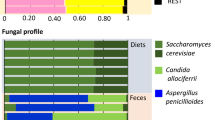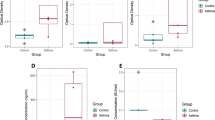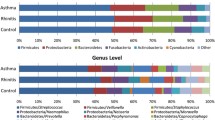Abstract
The two common species of house dust mites (HDMs), Dermatophagoides farinae and D. pteronyssinus, are major sources of allergens in human dwellings worldwide. Many allergens from HDMs have been described, but their extracts vary in immunogens. Mite strains may differ in their microbiomes, which affect mite allergen expression and contents of bacterial endotoxins. Some bacteria, such as the intracellular symbiont Cardinium, can affect both the sex ratio and biochemical pathways of mites, resulting in abundance variations of mite allergens/immunogens. Here, we investigated the bacterial microbiomes of D. farinae and D. pteronyssinus males and females using barcode 16S rDNA sequencing, qPCR, and genomic data analysis. We found a single species of Cardinium associated with D. farinae strains from the USA, China and Europe. Cardinium had high abundance relative to other bacterial taxa and represented 99% of all bacterial DNA reads from female mites from the USA. Cardinium was also abundant with respect to the number of host cells—we estimated 10.4–11.8 cells of Cardinium per single female mite cell. In a European D. farinae strain, Cardinium was more prevalent in females than in males (representing 92 and 67% of all bacterial taxa in females and males, respectively). In contrast, D. pteronyssinus lacked any Cardinium species, and the microbiomes of male and female mites were similar. We produced a Cardinium genome assembly (1.48 Mb; GenBank: PRJNA555788, GCA_007559345.1) associated with D. farinae. The ascertained ubiquity and abundance of Cardinium strongly suggest that this intracellular bacterium plays an important biological role in D. farinae.




Similar content being viewed by others
References
Altschul SF, Gish W, Miller W, Myers EW, Lipman DJ (1990) Basic local alignment search tool. J Mol Biol 215:403–410. https://doi.org/10.1016/S0022-2836(05)80360-2
Arlian LG, Confer PD, Rapp CM, Vyszenski-Moher DL, Chang JCS (1998) Population dynamics of the house dust mites Dermatophagoides farinae, D. pteronyssinus, and Euroglyphus maynei (Acari: Pyroglyphidae) at specific relative humidities. J Med Entomol 35:46–53. https://doi.org/10.1093/jmedent/35.1.46
Brinker P, Fontaine MC, Beukeboom LW, Falcao Salles J (2019) Host, symbionts, and the microbiome: the missing tripartite interaction. Trends Microbiol 27:480–488. https://doi.org/10.1016/j.tim.2019.02.002
Brown AMV, Wasala SK, Howe DK, Peetz AB, Zasada IA, Denver DR (2018) Comparative genomics of Wolbachia–Cardinium dual endosymbiosis in a plant-parasitic nematode. Front Microbiol 9:2482. https://doi.org/10.3389/fmicb.2018.02482
Casset A, Mari A, Purohit A, Resch Y, Weghofer M, Ferrara R, Thomas WR, Alessandri C, Chen K-W, de Blay F, Valenta R, Vrtala S (2012) Varying allergen composition and content affects the in vivo allergenic activity of commercial Dermatophagoides pteronyssinus extracts. Int Arch Allergy Immunol 159:253–262. https://doi.org/10.1159/000337654
Chan T-F, Ji K-M, Yim AK-Y, Liu X-Y, Zhou J-W, Li R-Q, Yang KY, Li J, Li M, Law PT-W, Wu Y-L, Cai Z-L, Qin H, Bao Y, Leung RK-L, Ng PK-S, Zou J, Zhong X-J, Ran P-X, Zhong N-S, Liu Z-G, Tsui SK-W (2015) The draft genome, transcriptome, and microbiome of Dermatophagoides farinae reveal a broad spectrum of dust mite allergens. J Allergy Clin Immunol 135:539–548. https://doi.org/10.1016/j.jaci.2014.09.031
Clarke KR (1993) Non-parametric multivariate analyses of changes in community structure. Aust J Ecol 18:117–143. https://doi.org/10.1111/j.1442-9993.1993.tb00438.x
Cole JR, Wang Q, Fish JA, Chai B, McGarrell DM, Sun Y, Brown CT, Porras-Alfaro A, Kuske CR, Tiedje JM (2014) Ribosomal Database Project: data and tools for high throughput rRNA analysis. Nucleic Acids Res 42:D633–D642. https://doi.org/10.1093/nar/gkt1244
Colloff MJ, Spieksma FTM (1992) Pictorial keys for the identification of domestic mites. Clin Exp Allergy 22:823–830. https://doi.org/10.1111/j.1365-2222.1992.tb02826.x
Cordaux R, Bouchon D, Greve P (2011) The impact of endosymbionts on the evolution of host sex-determination mechanisms. Trends Genet 27:332–341. https://doi.org/10.1016/j.tig.2011.05.002
Duron O, Hurst GDD, Hornett EA, Josling JA, Engelstadter J (2008) High incidence of the maternally inherited bacterium Cardinium in spiders. Mol Ecol 17:1427–1437. https://doi.org/10.1111/j.1365-294X.2008.03689.x
Dzoro S, Mittermann I, Resch-Marat Y, Vrtala S, Nehr M, Hirschl AM, Wikberg G, Lundeberg L, Johansson C, Scheynius A, Valenta R (2018) House dust mites as potential carriers for IgE sensitization to bacterial antigens. Allergy 73:115–124. https://doi.org/10.1111/all.13260
Earley ZM, Akhtar S, Green SJ, Naqib A, Khan O, Cannon AR, Hammer AM, Morris NL, Li X, Eberhardt JM, Gamelli RL, Kennedy RH, Choudhry MA (2015) Burn injury alters the intestinal microbiome and increases gut permeability and bacterial translocation. PLoS ONE 10:e0129996. https://doi.org/10.1371/journal.pone.0129996
Edgar RC (2013) UPARSE: highly accurate OTU sequences from microbial amplicon reads. Nat Methods 10:996–998. https://doi.org/10.1038/nmeth.2604
Erban T, Hubert J (2008) Digestive function of lysozyme in synanthropic acaridid mites enables utilization of bacteria as a food source. Exp Appl Acarol 44:199–212. https://doi.org/10.1007/s10493-008-9138-x
Erban T, Hubert J (2015) Two-dimensional gel proteomic analysis of Dermatophagoides farinae feces. Exp Appl Acarol 65:73–87. https://doi.org/10.1007/s10493-014-9848-1
Erban T, Klimov PB, Smrz J, Phillips TW, Nesvorna M, Kopecky J, Hubert J (2016a) Populations of stored product mite Tyrophagus putrescentiae differ in their bacterial communities. Front Microbiol 7:1046. https://doi.org/10.3389/fmicb.2016.01046
Erban T, Rybanska D, Harant K, Hortova B, Hubert J (2016b) Feces derived allergens of Tyrophagus putrescentiae reared on dried dog food and evidence of the strong nutritional interaction between the mite and Bacillus cereus producing protease bacillolysins and exo-chitinases. Front Physiol 7:53. https://doi.org/10.3389/fphys.2016.00053
Erban T, Harant K, Hubert J (2017a) Detailed two-dimensional gel proteomic mapping of the feces of the house dust mite Dermatophagoides pteronyssinus and comparison with D. farinae: reduced trypsin protease content in D. pteronyssinus and different isoforms. J Proteomics 162:11–19. https://doi.org/10.1016/j.jprot.2017.04.021
Erban T, Ledvinka O, Nesvorna M, Hubert J (2017b) Experimental manipulation shows a greater influence of population than dietary perturbation on the microbiome of Tyrophagus putrescentiae. Appl Environ Microbiol 83:e00128–e00117. https://doi.org/10.1128/AEM.00128-17
Erban T, Klimov P, Talacko P, Harant K, Hubert J (2020) Proteogenomics of the house dust mite, Dermatophagoides farinae: allergen repertoire, accurate allergen identification, isoforms, and sex-biased proteome differences. J Proteomics 210:103535. https://doi.org/10.1016/j.jprot.2019.103535
Fain A, Bochkov AV (2001) A review of the genus Cheyletus Latreille, 1776 (Acari: Cheyletidae). Bull Roy Belg Inst Nat Sci Entomol 71:83–114
Fast EM, Toomey ME, Panaram K, Desjardins D, Kolaczyk ED, Frydman HM (2011) Wolbachia enhance Drosophila stem cell proliferation and target the germline stem cell niche. Science 334:990–992. https://doi.org/10.1126/science.1209609
Fromont C, Adair KL, Douglas AE (2019) Correlation and causation between the microbiome, Wolbachia and host functional traits in natural populations of drosophilid flies. Mol Ecol 28:1826–1841. https://doi.org/10.1111/mec.15041
Green SJ, Venkatramanan R, Naqib A (2015) Deconstructing the polymerase chain reaction: understanding and correcting bias associated with primer degeneracies and primer-template mismatches. PLoS ONE 10:e0128122. https://doi.org/10.1371/journal.pone.0128122
Hammer O, Harper DAT, Ryan PD (2001) PAST: Paleontological statistics software package for education and data analysis. Palaeontol Electron 4:4. http://palaeo-electronica.org/2001_1/past/issue1_01.htm. Accessed 2 Jan 2020
Henszel L, Kalisinska E, Kosik-Bogacka DI, Kuzna-Grygiel W (2010) Mites in dust samples collected from sleeping places in apartments. Polish J Environ Stud 19:723–730
Hodgson RK (1976) Sex ratio and sex determination in the American house dust mite, Dermataphagoides farinae. Ann Entomol Soc Am 69:1085–1086. https://doi.org/10.1093/aesa/69.6.1085
Hubert J, Kopecky J, Sagova-Mareckova M, Nesvorna M, Zurek L, Erban T (2016a) Assessment of bacterial communities in thirteen species of laboratory-cultured domestic mites (Acari: Acaridida). J Econ Entomol 109:1887–1896. https://doi.org/10.1093/jee/tow089
Hubert J, Stejskal V, Nesvorna M, Aulicky R, Kopecky J, Erban T (2016b) Differences in the bacterial community of laboratory and wild populations of the predatory mite Cheyletus eruditus (Acarina: Cheyletidae) and bacteria transmission from its prey Acarus siro (Acari: Acaridae). J Econ Entomol 109:1450–1457. https://doi.org/10.1093/jee/tow032
Hubert J, Erban T, Kopecky J, Sopko B, Nesvorna M, Lichovnikova M, Schicht S, Strube C, Sparagano O (2017) Comparison of microbiomes between red poultry mite populations (Dermanyssus gallinae): predominance of Bartonella-like bacteria. Microb Ecol 74:947–960. https://doi.org/10.1007/s00248-017-0993-z
Hubert J, Nesvorna M, Klimov P, Dowd SE, Sopko B, Erban T (2019a) Differential allergen expression in three Tyrophagus putrescentiae strains inhabited by distinct microbiome. Allergy 74:2502–2507. https://doi.org/10.1111/all.13921
Hubert J, Nesvorna M, Kopecky J, Erban T, Klimov P (2019b) Population and culture age influence the microbiome profiles of house dust mites. Microb Ecol 77:1048–1066. https://doi.org/10.1007/s00248-018-1294-x
Katoh K, Standley DM (2013) MAFFT multiple sequence alignment software version 7: improvements in performance and usability. Mol Biol Evol 30(4):772–780. https://doi.org/10.1093/molbev/mst01010.1093/molbev/mst010
Kim JY, Yi M-H, Hwang Y, Lee JY, Lee I-Y, Yong D, Yong T-S (2018) 16S rRNA profiling of the Dermatophagoides farinae core microbiome: Enterococcus and Bartonella. Clin Exp Allergy 48:607–610. https://doi.org/10.1111/cea.13104
Kim JY, Yi M, Lee J, Lee I, Yong T (2019) Potential immunomodulatory effect of the house dust mite microbiome. Allergy 74(S106):863–863
Konecka E, Olszanowski Z (2019) First evidence of intracellular bacteria Cardinium in thermophilic mite Microzetorchestes emeryi (Acari: Oribatida): molecular screening of bacterial endosymbiont species. Curr Microbiol 76:1038–1044. https://doi.org/10.1007/s00284-019-01717-5
Kopecky J, Perotti MA, Nesvorna M, Erban T, Hubert J (2013) Cardinium endosymbionts are widespread in synanthropic mite species (Acari: Astigmata). J Invertebr Pathol 112:20–23. https://doi.org/10.1016/j.jip.2012.11.001
Kopecky J, Nesvorna M, Mareckova-Sagova M, Hubert J (2014) The effect of antibiotics on associated bacterial community of stored product mites. PLoS ONE 9:e112919. https://doi.org/10.1371/journal.pone.0112919
Kozich JJ, Westcott SL, Baxter NT, Highlander SK, Schloss PD (2013) Development of a dual-index sequencing strategy and curation pipeline for analyzing amplicon sequence data on the MiSeq Illumina sequencing platform. Appl Environ Microbiol 79:5112–5120. https://doi.org/10.1128/AEM.01043-13
Lee J, Kim JY, Yi M-h, Hwang Y, Lee I-Y, Nam S-H, Yong D, Yong T-S (2019) Comparative microbiome analysis of Dermatophagoides farinae, Dermatophagoides pteronyssinus, and Tyrophagus putrescentiae. J Allergy Clin Immunol 143:1620–1623. https://doi.org/10.1016/j.jaci.2018.10.062
Li H, Durbin R (2009) Fast and accurate short read alignment with Burrows–Wheeler transform. Bioinformatics 25:1754–1760. https://doi.org/10.1093/bioinformatics/btp324
Li H, Handsaker B, Wysoker A, Fennell T, Ruan J, Homer N, Marth G, Abecasis G, Durbin R, 1000 Genome Project Data Processing Subgroup (2009) The Sequence Alignment/Map format and SAMtools. Bioinformatics 25:2078–2079. https://doi.org/10.1093/bioinformatics/btp352
Lu J, Breitwieser FP, Thielen P, Salzberg SL (2017) Bracken: estimating species abundance in metagenomics data. PeerJ Comp Sci 3:e104. https://doi.org/10.7717/peerj-cs.104
Malgorzata-Miller G, Heinbockel L, Brandenburg K, van der Meer JWM, Netea MG, Joosten LAB (2016) Bartonella quintana lipopolysaccharide (LPS): structure and characteristics of a potent TLR4 antagonist for in-vitro and in-vivo applications. Sci Rep 6:34221. https://doi.org/10.1038/srep34221
Molva V, Nesvorna M, Hubert J (2019) Feeding interactions between microorganisms and the house dust mites Dermatophagoides pteronyssinus and Dermatophagoides farinae (Astigmata: Pyroglyphidae). J Med Entomol 56:1669–1677. https://doi.org/10.1093/jme/tjz089
Molva V, Bostlova M, Nesvorna M, Hubert J (2020) Do the microorganisms from laboratory culture spent growth medium affect house dust mite fitness and microbiome composition? Insect Sci 27:266–275. https://doi.org/10.1111/1744-7917.12636
Mondal M, Klimov P, Flynt AS (2018) Rewired RNAi-mediated genome surveillance in house dust mites. PLoS Genet 14:e1007183. https://doi.org/10.1371/journal.pgen.1007183
Nakamura Y, Kawai S, Yukuhiro F, Ito S, Gotoh T, Kisimoto R, Yanase T, Matsumoto Y, Kageyama D, Noda H (2009) Prevalence of Cardinium bacteria in planthoppers and spider mites and taxonomic revision of “Candidatus Cardinium hertigii” based on detection of a new Cardinium group from biting midges. Appl Environ Microbiol 75:6757–6763. https://doi.org/10.1128/AEM.01583-09
Nesvorna M, Bittner V, Hubert J (2019) The mite Tyrophagus putrescentiae hosts population-specific microbiomes that respond weakly to starvation. Microb Ecol 77:488–501. https://doi.org/10.1007/s00248-018-1224-y
Nordengrun M, Michalik S, Volker U, Broker BM, Gomez-Gascon L (2018) The quest for bacterial allergens. Int J Med Microbiol 308:738–750. https://doi.org/10.1016/j.ijmm.2018.04.003
Ondov BD, Bergman NH, Phillippy AM (2011) Interactive metagenomic visualization in a web browser. BMC Bioinformatics 12:385. https://doi.org/10.1186/1471-2105-12-385
Penz T, Schmitz-Esser S, Kelly SE, Cass BN, Muller A, Woyke T, Malfatti SA, Hunter MS, Horn M (2012) Comparative genomics suggests an independent origin of cytoplasmic incompatibility in Cardinium hertigii. PLoS Genet 8:e1003012. https://doi.org/10.1371/journal.pgen.1003012
Platts-Mills TAE, de Weck AL (1989) Dust mite allergens and asthma—a worldwide problem. J Allergy Clin Immunol 83:416–427. https://doi.org/10.1016/0091-6749(89)90128-0
Platts-Mills TAE, Woodfolk JA (2011) Allergens and their role in the allergic immune response. Immunol Rev 242:51–68. https://doi.org/10.1111/j.1600-065X.2011.01021.x
Popa C, Abdollahi-Roodsaz S, Joosten LAB, Takahashi N, Sprong T, Matera G, Liberto MC, Foca A, van Deuren M, Kullberg BJ, van den Berg WB, van der Meer JWM, Netea MG (2007) Bartonella quintana lipopolysaccharide is a natural antagonist of Toll-like receptor 4. Infect Immun 75:4831–4837. https://doi.org/10.1128/IAI.00237-07
Quast C, Pruesse E, Yilmaz P, Gerken J, Schweer T, Yarza P, Peplies J, Glockner FO (2013) The SILVA ribosomal RNA gene database project: improved data processing and web-based tools. Nucleic Acids Res 41:D590–D596. https://doi.org/10.1093/nar/gks1219
Rognes T, Flouri T, Nichols B, Quince C, Mahe F (2016) VSEARCH: a versatile open source tool for metagenomics. PeerJ 4:e2584. https://doi.org/10.7717/peerj.2584
Rudman SM, Greenblum S, Hughes RC, Rajpurohit S, Kiratli O, Lowder DB, Lemmon SG, Petrov DA, Chaston JM, Schmidt P (2019) Microbiome composition shapes rapid genomic adaptation of Drosophila melanogaster. Proc Natl Acad Sci U S A 116:20025–20032. https://doi.org/10.1073/pnas.1907787116
Schloss PD, Westcott SL, Ryabin T, Hall JR, Hartmann M, Hollister EB, Lesniewski RA, Oakley BB, Parks DH, Robinson CJ, Sahl JW, Stres B, Thallinger GG, Van Horn DJ, Weber CF (2009) Introducing mothur: open-source, platform-independent, community-supported software for describing and comparing microbial communities. Appl Environ Microbiol 75:7537–7541. https://doi.org/10.1128/AEM.01541-09
Sinha RN (1966) Feeding and reproduction of some stored-product mites on seed-borne fungi. J Econ Entomol 59:1227–1232
SourceForge (2014) BBMap. SourceForge.net. https://sourceforge.net/projects/bbmap/. Accessed 17 July 2019
Stamatakis A (2014) RAxML version 8: a tool for phylogenetic analysis and post-analysis of large phylogenies. Bioinformatics 30:1312–1313. https://doi.org/10.1093/bioinformatics/btu033
Stouthamer CM, Kelly SE, Mann E, Schmitz-Esser S, Hunter MS (2019) Development of a multi-locus sequence typing system helps reveal the evolution of Cardinium hertigii, a reproductive manipulator symbiont of insects. BMC Microbiol 19:266. https://doi.org/10.1186/s12866-019-1638-9
Trivedi B, Valerio C, Slater JE (2003) Endotoxin content of standardized allergen vaccines. J Allergy Clin Immunol 111:777–783. https://doi.org/10.1067/mai.2003.1338
Valerio C, Murray P, Arlian LG, Slater JE (2004) Endotoxin in dust mite allergen extracts. J Allergy Clin Immunol 113:S136–S137. https://doi.org/10.1016/j.jaci.2003.12.489
Valerio CR, Murray P, Arlian LG, Slater JE (2005) Bacterial 16S ribosomal DNA in house dust mite cultures. J Allergy Clin Immunol 116:1296–1300. https://doi.org/10.1016/j.jaci.2005.09.046
Valerio C, Arlian LG, Slater JE (2009) Bacterial DNA sequences isolated from standardized dust mite extracts and wild mites. J Allergy Clin Immunol 123:S216–S216. https://doi.org/10.1016/j.jaci.2008.12.826
Vidal-Quist JC, Ortego F, Lombardero M, Castanera P, Hernandez-Crespo P (2015) Allergen expression in the European house dust mite Dermatophagoides pteronyssinus throughout development and response to environmental conditions. Med Vet Entomol 29:137–146. https://doi.org/10.1111/mve.12102
Warton DI, Wright TW, Wang Y (2012) Distance-based multivariate analyses confound location and dispersion effects. Methods Ecol Evol 3:89–101. https://doi.org/10.1111/j.2041-210X.2011.00127.x
WHO/IUIS (World Health Organization/International Union of Immunological Societies) (2020) Allergen nomenclature. WHO/IUIS Allergen Nomenclature Sub-Committee. http://www.allergen.org. Accessed 21 Jan 2020
Williams LK, Ownby DR, Maliarik MJ, Johnson CC (2005) The role of endotoxin and its receptors in allergic disease. Ann Allergy Asthma Immunol 94:323–332. https://doi.org/10.1016/S1081-1206(10)60983-0
Wilson ACC, Duncan RP (2015) Signatures of host/symbiont genome coevolution in insect nutritional endosymbioses. Proc Natl Acad Sci U S A 112:10255–10261. https://doi.org/10.1073/pnas.1423305112
Wood DE, Salzberg SL (2014) Kraken: ultrafast metagenomic sequence classification using exact alignments. Genome Biol 15:R46. https://doi.org/10.1186/gb-2014-15-3-r46
Wybouw N, Van Leeuwen T, Dermauw W (2018) A massive incorporation of microbial genes into the genome of Tetranychus urticae, a polyphagous arthropod herbivore. Insect Mol Biol 27:333–351. https://doi.org/10.1111/imb.12374
Zchori-Fein E, Perlman SJ (2004) Distribution of the bacterial symbiont Cardinium in arthropods. Mol Ecol 13:2009–2016. https://doi.org/10.1111/j.1365-294X.2004.02203.x
Acknowledgements
We thank Julie Chalupnikova and Martin Markovic for their valuable help. We also thank Barry OConnor for critical reading of an early draft of the manuscript.
Funding
This study was supported by Grant No. 17-12068S from the Czech Science Foundation (GACR) (https://gacr.cz/) and by Grant No. RO0418 from the Ministry of Agriculture of the Czech Republic (http://eagri.cz/). PBK was supported by a Grant from the Russian Science Foundation, Project No. 19-14-00004 (Cardinium whole genome sequencing, assembling and phylogenetic analysis).
Author information
Authors and Affiliations
Contributions
TE, PK and JH conceived and designed the experiments. PK, JH, and VM analyzed and interpreted the data. TE and PK wrote the manuscript. All authors read and approved the final manuscript.
Corresponding author
Ethics declarations
Conflict of interest
The authors declare that they have no relevant conflict of interest.
Additional information
Publisher's Note
Springer Nature remains neutral with regard to jurisdictional claims in published maps and institutional affiliations.
Electronic supplementary material
Below is the link to the electronic supplementary material.
Rights and permissions
About this article
Cite this article
Erban, T., Klimov, P., Molva, V. et al. Whole genomic sequencing and sex-dependent abundance estimation of Cardinium sp., a common and hyperabundant bacterial endosymbiont of the American house dust mite, Dermatophagoides farinae. Exp Appl Acarol 80, 363–380 (2020). https://doi.org/10.1007/s10493-020-00475-5
Received:
Accepted:
Published:
Issue Date:
DOI: https://doi.org/10.1007/s10493-020-00475-5




